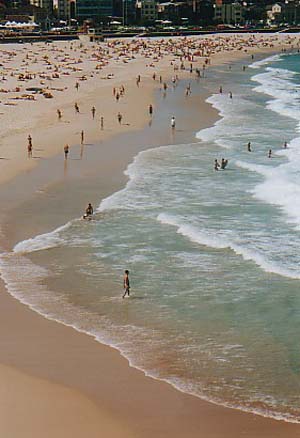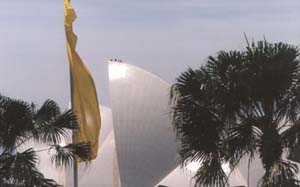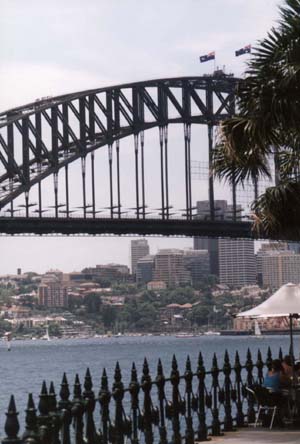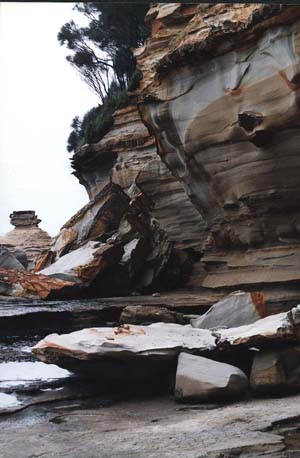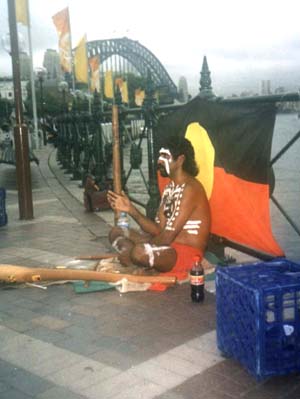|
|
Sydney,
Australia: Surf, Sun and Suds Every fall when the last leaf tumbles from the big Maple in our back yard and the wind develops a raw edge, a quiet yearning creeps over me. I want to escape before the hard fist of winter comes around the corner. So last year on a whim, my wife and I kissed goodbye to our high-stress jobs and left to spend the winter in Australia. Soon we were ensconced like Bohemians in a backstreet rowhouse in the Sydney enclave of Darlinghurst, so densely packed in with our neighbours that, although we never saw them, we knew them almost intimately for every window was open 24-hrs a day to catch the slightest breeze. By bus and ferry we explored the long series of deep sculpted bays with which Sydney is blessed: Bondi, Manley, Curl Curl, Dee Why, Cogee, Bronte, Maroubra and more. |
|||
At each one, deep blue waves swell in from hundreds of miles away to curl, crash and foam onto sparkling sandy beaches. Rugged sandstone cliffs stand at each end of the beach like gnarled and weather-beaten guardians. All this under a hot sun that glares down like the giant eye of a cyclops, baking everything below. Bondi became our regular beach, a short hop on #91 bus crowded with office workers, shoppers, sun-worshipers like us, and youngsters toting surf boards ranging from small boogie boards to massive planks taller than their owners. Instead of spending time at the malls, Sydneysiders congregate at beaches at every opportunity — it’s a very relaxing way of life. After school, teenagers race to the beach where they throw on wet suits and astride their boards bob in the swell waiting for the perfect wave to carry them in to the perfect beach. And, scanning surreptitiously amongst the colourful blankets arrayed on the sand, I was often rewarded by the sight of young damsels seeking the ultimate tan, topless and attired only in the skimpiest thongs. As naive newcomers, we kept a wary eye seaward for the helicopters throbbing regularly over the beaches, like traffic reports in North America, they provide shark updates to local radio stations. Most lives, however, are lost to the deep blue sea not from sharks but from immense waves and powerful rips can come up even on a quiet day. Life-saving clubs were instituted over a century ago and today every beach has its own club with muscular, well-oiled men and women patrolling the beach wearing beanies in their club colours and skimpy “bathers.” These amateurs, who have saved thousands of lives, hold regular surf life-saving competitions that are fiercely competitive and extremely popular. In the feature event, large life-saving boats rowed by four and with a “sweep” standing at the rudder must go out through the breaking rollers and around a course. The boats are often tossed and capsized like match sticks in the pounding surf. Australians have another passion — sailing. And there is no better place in the world to unfurl a mainsail and jib than Sydney Harbour, where thousands of yachts and dinghies of every size criss-cross the harbour in seemingly random patterns, their glistening white sails full with wind like small replicas of the looming Opera House. Immense freighters, cruise ships and dark-green harbour ferries churn imperiously through the madcap flotilla in ruler-straight lines. One day friends took us out for a “casual” afternoon regatta. With a can of Victoria Bitter in one hand, and the other hand clinging desperately to anything solid, we were exhilarated as our boat raced from one tack to another, keeling over almost to horizontal and sending spray flying in the stiff breeze. Our hearts were pounding wildly for we repeatedly came within inches of barrelling into other boats before one of the skippers gave way in their strategic game of tacking. Our Aussie crew, however, was nonchalant, “Sorry, not much of a blow today, mate.” Then the race was over, the wind stilled, and the setting sun cast a soft burnished gold on the orange tile roofs and white stucco houses terraced along the shore. We sailed slowly under the Harbour Bridge, past the Opera House glowing a rich orange from the last light of day, and back to the marina. Soon we were in one of the hundreds of pubs and restaurants lining the shore and dotted throughout every corner of the city. The windows were thrown wide open so you could hear and feel the throbbing life of the city and hear the distant surf. Dining out in Australia is popular, for it is much more affordable than in North America. Not only are prices reasonable, but there is no tipping. The cuisine is excellent and, given Australia’s geographic location, has a distinct Asian flavour including spicy Thai, Vietnamese, and Chinese dishes. Best of all, you are allowed to bring your own wine to most restaurants. We became accustomed to seeing a diner suddenly jump up and race out of the restaurant, only to return a few minutes later waving a bottle of Chardonnay or Shiraz. As I write this (back home) I can feel the cold wind outside carrying traces of snow across a monochrome leaden landscape and I yearn to be sitting in an out-door café by the ocean, my skin tight from sunburn and tingling from salt. If You Go Here are some useful websites. The official website of Australia Note: one Australian dollar = $.72 US A visa is required; for visits less
than three months, your travel agent will arrange it. |
||||
© 2005 All photographs by Hans Tammemagi |
||||
